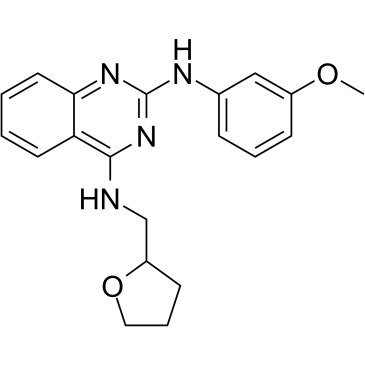Physicochemical Properties
| Molecular Formula | C20H22N4O2 |
| Molecular Weight | 350.41 |
| Exact Mass | 350.174 |
| Elemental Analysis | C, 68.55; H, 6.33; N, 15.99; O, 9.13 |
| CAS # | 796888-12-5 |
| Related CAS # | 796888-12-5;1049788-58-0 (HCl); |
| PubChem CID | 2951910 |
| Appearance | white solid powder |
| Density | 1.3±0.1 g/cm3 |
| Boiling Point | 580.0±58.0 °C at 760 mmHg |
| Flash Point | 304.6±32.3 °C |
| Vapour Pressure | 0.0±1.6 mmHg at 25°C |
| Index of Refraction | 1.680 |
| LogP | 2.18 |
| Hydrogen Bond Donor Count | 2 |
| Hydrogen Bond Acceptor Count | 6 |
| Rotatable Bond Count | 6 |
| Heavy Atom Count | 26 |
| Complexity | 438 |
| Defined Atom Stereocenter Count | 0 |
| SMILES | N1C2C(=CC=CC=2)C(NCC2CCCO2)=NC=1NC1C=C(OC)C=CC=1 |
| InChi Key | FBWZAFQEOKNGQL-UHFFFAOYSA-N |
| InChi Code | InChI=1S/C20H22N4O2/c1-25-15-7-4-6-14(12-15)22-20-23-18-10-3-2-9-17(18)19(24-20)21-13-16-8-5-11-26-16/h2-4,6-7,9-10,12,16H,5,8,11,13H2,1H3,(H2,21,22,23,24) |
| Chemical Name | 2-N-(3-methoxyphenyl)-4-N-(oxolan-2-ylmethyl)quinazoline-2,4-diamine |
| Synonyms | GNF-PF-2356; LCH 7749944; LCH-7749944; LCH7749944 |
| HS Tariff Code | 2934.99.9001 |
| Storage |
Powder-20°C 3 years 4°C 2 years In solvent -80°C 6 months -20°C 1 month |
| Shipping Condition | Room temperature (This product is stable at ambient temperature for a few days during ordinary shipping and time spent in Customs) |
Biological Activity
| Targets | PAK4 (IC50 = 14.93 μM) |
| ln Vitro | In a concentration-inhibitory manner, LCH-7749944 (GNF-PF-2356; 5-50 μM; 24 hours) reduces the proliferation of MKN-1, BGC823, SGC7901, and MGC803 cells [1]. 12 LCH-7749944 (5 -20 μM) The application of LCH-7749944 (5 – 20 μM; 12-48 hours) to promote SGC7901 cell counts[1] results in a dose-monitored rise in the total number of cells in the G1 phase and a decrease in the total number of cells in the S phase. |
| Cell Assay |
Cell Proliferation Assay[1] Cell Types: -7749944 (5-30 μM; 24 hrs (hours)) Dramatically reduces phosphPAK4, phospho-c-Src, phospho-EGFR and cyclin D1 protein expression levels in a dose-dependent manner[1]. MKN-1, BGC823, SGC7901 and MGC803 human gastric cancer cells Tested Concentrations: 5, 10, 15, 20, 25, 30, 35, 40, 45, 50 μM Incubation Duration: 24 hrs (hours) Experimental Results: Inhibition of MKN-1, BGC823, SGC7901 and MGC803 cells in a concentration-dependent manner. Apoptosis analysis [1] Cell Types: SGC7901 Cell Tested Concentrations: 5, 10, 20 μM Incubation Duration: 12, 24, 48 hrs (hours) Experimental Results: Induced apoptosis of SGC7901 cells. Cell cycle analysis [1] Cell Types: SGC7901 Cell Tested Concentrations: 5, 10, 20 μM Incubation Duration: 12, 24, 48 hrs (hours) Experimental Results: Dramatically induced a dose-dependent increase in the percentage of cells in G1 phase and a decrease in the percentage of cells in S phase. Western Blot Analysis [1] Cell Types: SGC7901 Cell Tested Concentrations: 5, 10, 20, 30 μM Incubation Duration: 24 hrs (hours) Experimental Results: Phosphorylated PAK4, phos |
| References |
[1]. LCH-7749944, a novel and potent p21-activated kinase 4 inhibitor, suppresses proliferation and invasion in human gastric cancer cells. Cancer Lett. 2012 Apr 1;317(1):24-32. |
Solubility Data
| Solubility (In Vitro) |
DMSO: 70~250 mg/mL (199.8~713.5 mM) Ethanol: ~70 mg/mL (~199.78 mM) |
| Solubility (In Vivo) |
Solubility in Formulation 1: ≥ 2.17 mg/mL (6.19 mM) (saturation unknown) in 10% DMSO + 40% PEG300 + 5% Tween80 + 45% Saline (add these co-solvents sequentially from left to right, and one by one), clear solution. For example, if 1 mL of working solution is to be prepared, you can add 100 μL of 21.7 mg/mL clear DMSO stock solution to 400 μL PEG300 and mix evenly; then add 50 μL Tween-80 to the above solution and mix evenly; then add 450 μL normal saline to adjust the volume to 1 mL. Preparation of saline: Dissolve 0.9 g of sodium chloride in 100 mL ddH₂ O to obtain a clear solution. Solubility in Formulation 2: ≥ 2.17 mg/mL (6.19 mM) (saturation unknown) in 10% DMSO + 90% (20% SBE-β-CD in Saline) (add these co-solvents sequentially from left to right, and one by one), clear solution. For example, if 1 mL of working solution is to be prepared, you can add 100 μL of 21.7 mg/mL clear DMSO stock solution to 900 μL of 20% SBE-β-CD physiological saline solution and mix evenly. Preparation of 20% SBE-β-CD in Saline (4°C,1 week): Dissolve 2 g SBE-β-CD in 10 mL saline to obtain a clear solution. (Please use freshly prepared in vivo formulations for optimal results.) |
| Preparing Stock Solutions | 1 mg | 5 mg | 10 mg | |
| 1 mM | 2.8538 mL | 14.2690 mL | 28.5380 mL | |
| 5 mM | 0.5708 mL | 2.8538 mL | 5.7076 mL | |
| 10 mM | 0.2854 mL | 1.4269 mL | 2.8538 mL |
